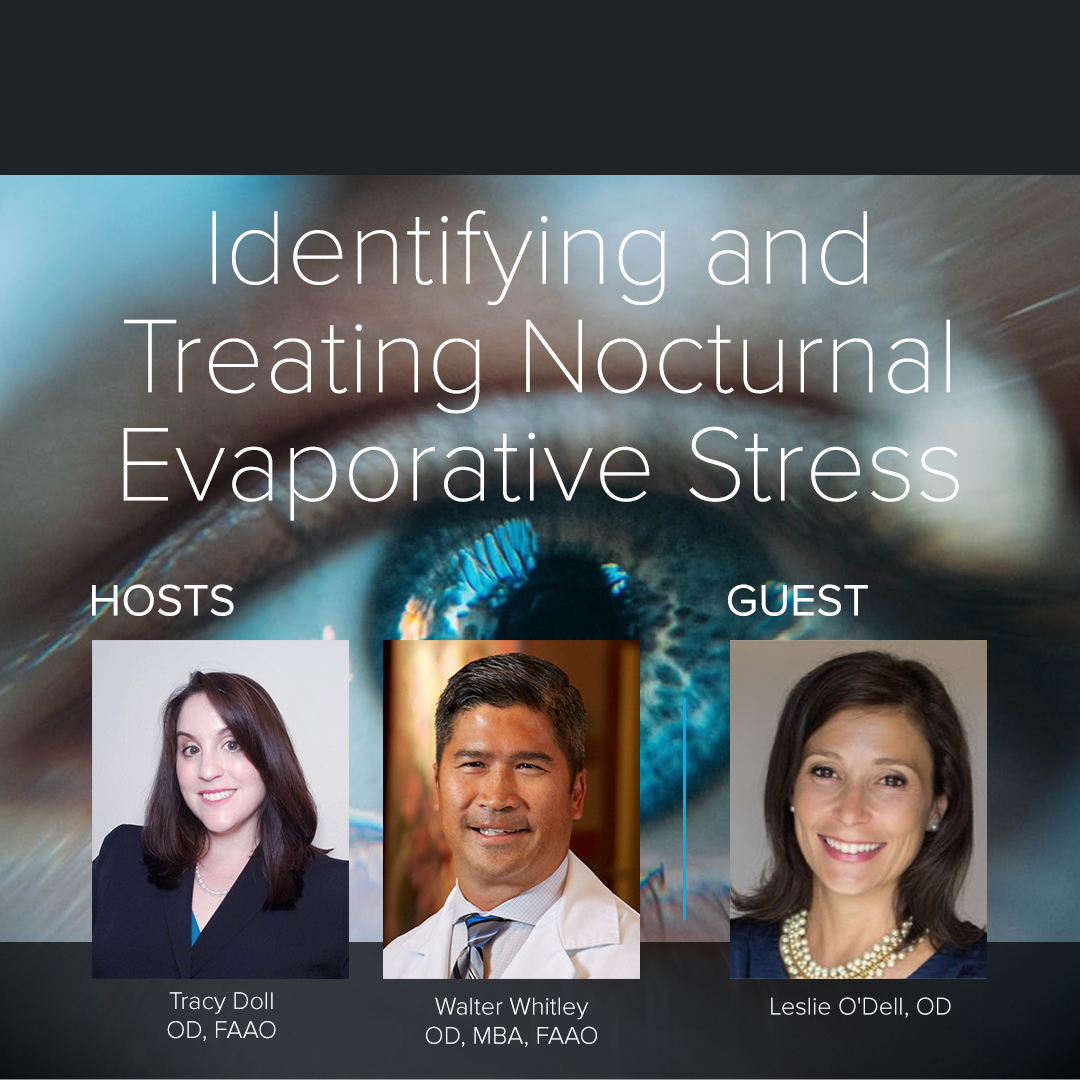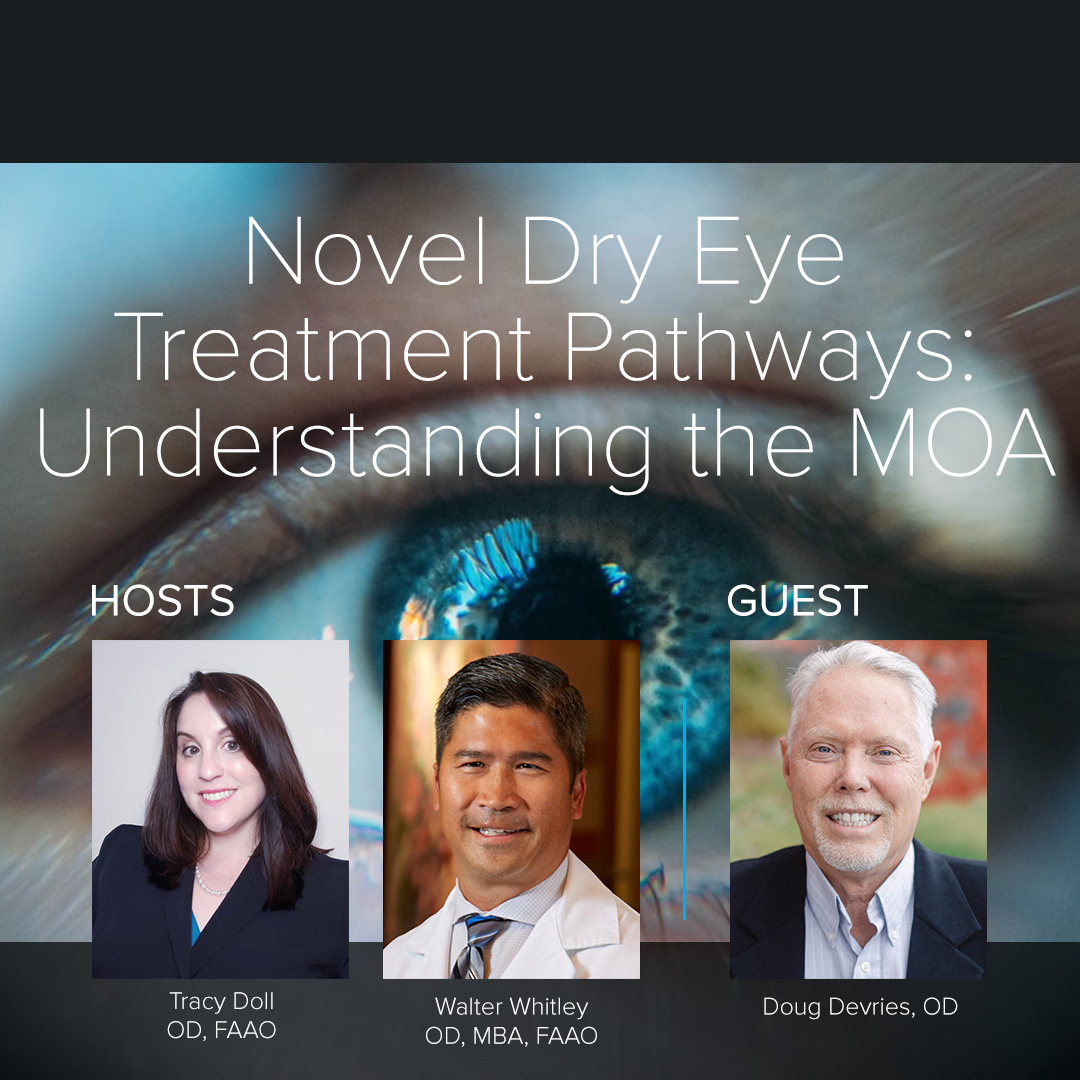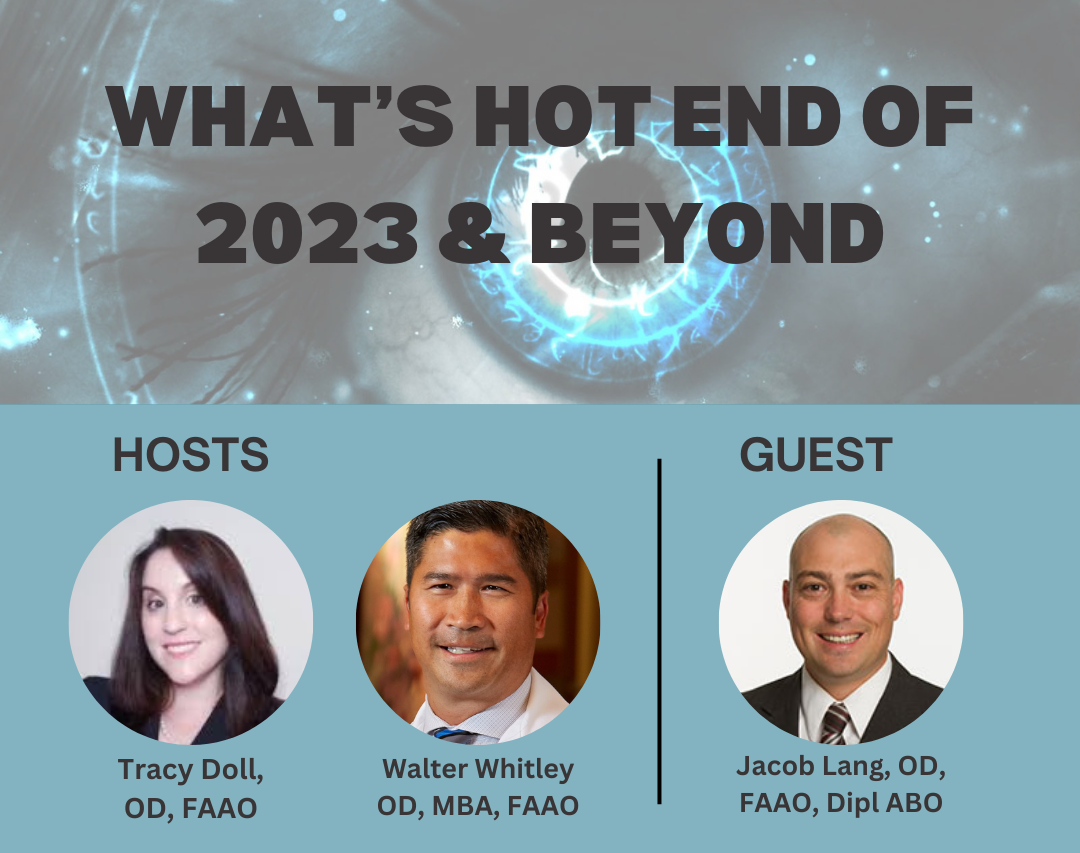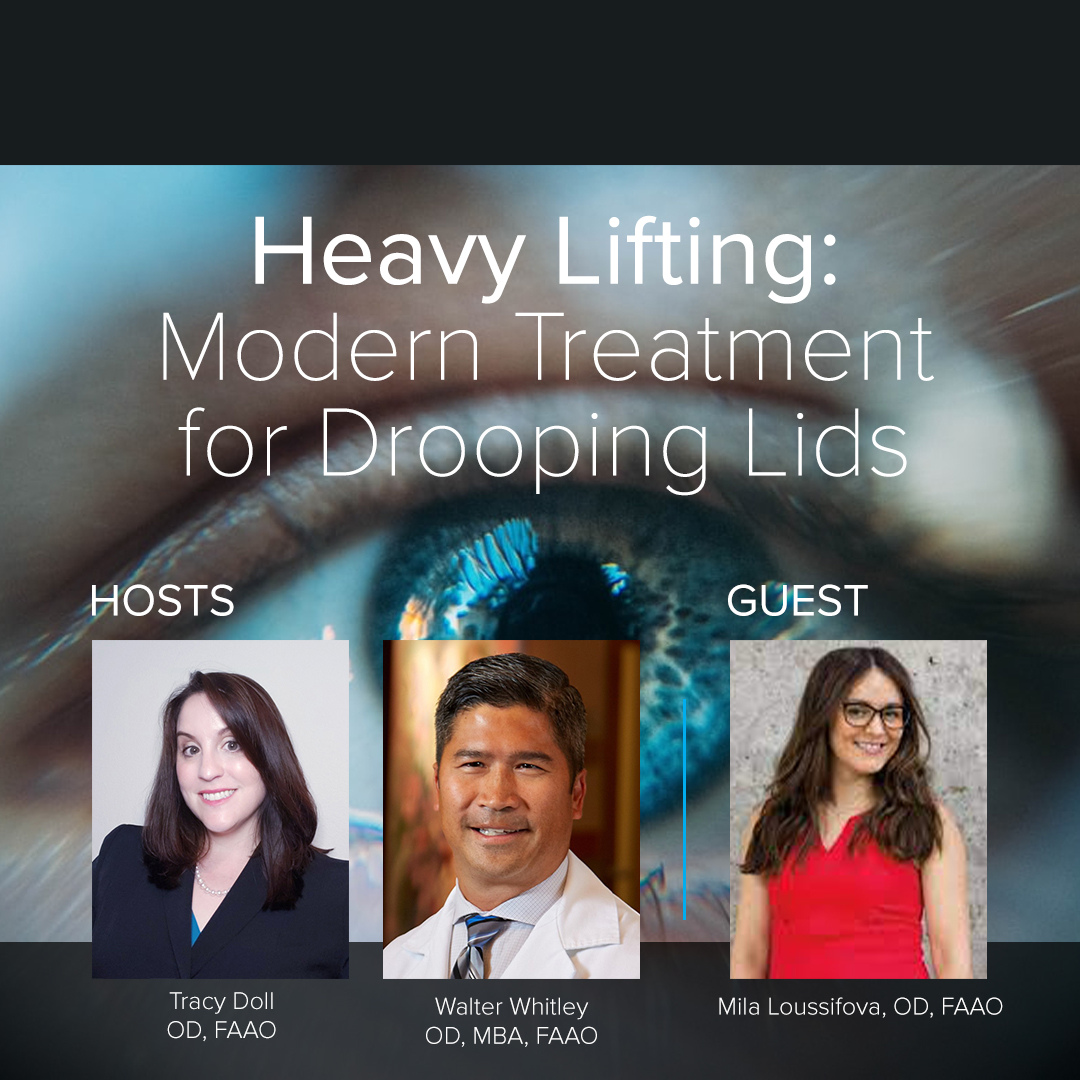Episode Transcript
[00:00:00] Speaker A: Welcome to the Dry Eye podcast series. Click on dry Eye, your insider path to the most exclusive dry eye topics. The series will raise awareness about the current and future state of ocular surface disease. The podcasts will focus on a variety of topics. Before we get to our next episode, here's a quick word from our sponsor.
[00:00:19] Speaker B: In today's episode, we have the pleasure of speaking with our very own dry eye coach, Doctor Tracy Dahl, who practices at Sunset Eye Clinic in Oregon. Welcome, Tracy.
[00:00:32] Speaker A: Thank you for having me, Walt. I'm so excited to be able to do this interview with you today.
[00:00:37] Speaker B: So what I want to do for this episode is talk to you about lashes. What is this craze with lashes going on these days? And I know you have a lot to say, so you pick what your favorites, and we'll go from there.
[00:00:48] Speaker A: Okay.
The newest trend, and probably the fastest growing trend in all of makeup is the obsession with growing the length of eyelashes to great lengths in order to properly divert airflow away from the eye. The eyelashes should actually be about one third the width of the eye. So have you ever seen a giraffe? Well, giraffes have incredibly long eyelashes because they have gigantic eyeballs, right? So it tends to go for all mammalian species, including humans. That. That is the proper health length for eyelashes. When you mess with this alteration, you kind of make that grow too long. You actually could end up getting debris and allergens and wind going straight to the front surface of your eye, which is what we do not want for patients. So this complete obsession growing lashes long is not actually a healthy one.
[00:01:42] Speaker B: I got to be honest, I've never seen a giraffe eye, but I'll google it after this.
[00:01:46] Speaker A: You want to see another weird one? Ostriches. They're also a little.
[00:01:50] Speaker B: Well, I'm pretty sure this zoom thing and this facetime thing, it's got to have a little impact there. Any comments on that?
[00:01:59] Speaker A: Well, for a while, the only part of the face that we were actually seeing was physically the structure of the eyes. But it's turning out that the basic concept of having people look at themselves consistently while they're at work, this is something that's new that we haven't ever encountered in history before. So I used to lecture for a living, and I would even not know how I looked. So the fact that you're having a conversation with other people and you're suddenly seeing yourself for the first time and how you phrase things, how you appear, this is actually pushing people to more and more, both for cosmetic surgeries and actual makeup to enhance the appearance. There was a study out of Australia that interviewed people, and I think it was about 300 to 400 individuals, and they asked them, what are you looking at during your Zoom meetings? Whether that was for recreation or work. And a quarter of the respondents, do you know where they were looking the entire time?
[00:02:56] Speaker B: Themselves?
[00:02:57] Speaker A: Yeah, only at themselves. They were, they were not looking at, they were not paying attention to anything else, not the content of the meeting. They were very obsessed with how they appeared to other people on the screen. So this desire to look better on camera was kind of moving everybody into wanting to do more cosmetic and cosmetic enhancements, the lashes being one of the fastest growing trends. So what other questions do you have for me on eyelashes?
[00:03:23] Speaker B: So, you know, where do I start? You know, what do I tell my female patients?
[00:03:28] Speaker A: So you get asked a lot like, well, how is. Is it safe to grow my lashes? Is there anything that can make my eyelashes grow longer? What we wanted to encourage our patients to do is not to go for lash length, but more for healthy, thick lashes. So when we're looking at prostaglandin analogs, the prescriptive version was actually helpful by the fact that it would educate patients on the potential side effects. So we know that by law, pharmaceuticals actually have to list the potential, what side effects the ingredients can have. And the matoprost actually causes the eyelash follicle to increase the lash length and actually add extra pigmentation during the antigen phase. So that sounds great, and that sounds wonderful. And I first experienced these side effects from mimatoprost while working in the Veterans Administration. We would get these veterans with incredibly beautiful long eyelashes or sometimes really stumpy eyelashes because they would actually take scissors and cut them off because they'd be hitting their glasses. But as you know, that prostaglandin analogues don't come without the potential for side effects. So have you seen the classic side effects of prostaglandin analogs? You're going to get red eyes, irritated eyes, the potential for pigmentation of lid margin, and with the drop form, also alterations in the coloration of the iris. These side effects are not without the ability to happen, even with the topically applied prostaglandin analogs that are just meant to be painted along the lashes. Anyone that's considering taking these needs to be carefully monitored for side effects, just like you would be monitoring a glaucoma patient, because if that patient does get hyperemia, if they are getting alterations, and that they may not want, cosmetically, they may not be realizing it. So anytime I get a doctor who's thinking about jumping on either the prescriptive version of it or a synthetic version, I really, really highly recommend that they monitor these patients, because it seems like either you love it or you don't.
I research project during the pandemic, when all of us were kind of stuck home, I interviewed about 200 users and split down the middle. It was kind of a love hate relationship. Either they tolerated it and did really well, or the other half really had substantial side effects. It was a little bit over 40% of patients who discontinued using, or respondents that discontinued using these prostaglandin analogs, the main reason being side effects. Second one being cost.
[00:05:57] Speaker B: Yeah.
[00:05:58] Speaker A: So, so if you've got a patient that wants this, I actually push them more towards lash conditioners instead. So more amino acid polypeptide base that supports the growth of lashes and make the lashes thicker and healthier instead of longer. Because ultimately what people are looking for is that darkening effect, where that gives that the eyelash margin a little bit more of a pop to it. So thicker, not longer, is better.
[00:06:25] Speaker B: So tell me about growth serums.
[00:06:28] Speaker A: So, that's what we're talking about with growth serums.
[00:06:31] Speaker B: Okay. Okay.
[00:06:31] Speaker A: So we don't want, we don't want to force extra long growth. We want. We want to encourage healthy growth of eyelashes. You also want to ascertain why the patient may have short, not healthy lashes to begin with. So if the eyelids are inflamed, if there's blepharitis going on, if there are eyelids, skin conditions like eyelid eczema, all of those will actually contribute to unhealthy eyelash growth. So the great majority of my patients who I'm treating for ocular surface dryness, once we get those eyelids cleaned up and calmed down over time, those lashes actually start to get healthier and grow longer. It's a pretty frequent comment that I get from my patients that tell me that they're surprised about how good their lashes look, and they were just trying to get rid of the redness in their eyes.
[00:07:19] Speaker B: So what's a tent? What's a lift? I mean, there's so many different lash things going on. Help me.
[00:07:23] Speaker A: Right. So a tint is what it sounds like. So tint, you know, like color, like tinting your hair. And I've got to be honest with you, the ingredients for a lash tint are chemically identical to what you'd be using in hair dye. So any patient that's considering doing this needs to make sure that they get patch tested first, or if they have an allergy to hair dye. That's definitely a no go. The truth is that the lid seal is not completely airtight or watertight. So anything that's going to be applied to the lash margin has the ability to get into the eye. So the idea of tinting the lashes is to do more of like a permanent mascara and get those lashes look nice and dark. It just has to be done very carefully. I tell patients to avoid the diY. This is not something that you do it yourself at home with. You definitely want to go to a licensed esthetician who has becomes highly recommended by somebody that you know who has done it, not just like somebody's cousin Susie in the basement. This has to be a licensed individual who has a good reputation and certificates on the wall. Okay.
A lash lift is slightly different because that's actually perming solution that's applied to the eyelashes. So now we've got hair dye and perming solution applied to the eyelashes too. That is to meant to kind of lift the eyelashes up and curl them away from the eye. In this case, you're going to get the lashes that are kind of glued or put to a sticky rod, so they're going to curl up and then that perming solutions upset there and allowed to sit.
In that case, you're going to get a lot of hydrogen peroxide involved with the situation, because that's what is in.
That's what's in perming solution.
Diglockolates in it. So if anyone has an allergy to perming solution, definitely not going to be a candidate for this one. And unfortunately, once that perming solution gets into the lashes, it's going to take the life long of that lash to get it out. So if a patient has a hyper reaction to this, you're talking about having to chronically treat that patient for a couple of months of anti inflammatories until the allergen goes away.
So I've had to employ things like amniotic membranes, topical steroids, anti allergy drops to help patients to recover from that. And once again, they do sell do it yourself kits to do this. This is something to absolutely discourage patients from doing. So healthy lash growth with healthy eye cosmetics is better than the chemical treatments.
[00:09:55] Speaker B: Well, since we're amongst friends here, you and me, can you help me understand? I've had patients come in, their eyes are irritated, their eyelashes are like, seems like two inches long, and I know they're fake. Can you help me understand what is the process? So they go in, they want fake Lilash extension. There's glee, there's glue or something. How long does that last? How often are they supposed to change them?
Understand this process?
[00:10:20] Speaker A: So we kind of went through the chemical processes. We went through the prostaglandins. The next thing that people like to do is to artificially elongate by attaching a single synthetic, or it could be a real lash to their existing lash. This is a two to four hour procedure, depending on how thick they want these lashes to appear. So it's literally an aesthetician taking an individual lash, dipping it in glue, sticking it to the current lash, taking another individual lash, sticking it in a glue pot, then sticking it directly to the lash. This is very intensely, this is very, very time.
The main issue with the glues where people have allergic reactions and problems is because the glues contain latex and formaldehyde, very, very strong preservatives that can be very irritating to the ocular surface. Then, because of the normal eyelash growth cycle, patients are going to have to, or clients are going to have to go back and have this repeated in about two to three weeks. This is a very time intensive, very expensive process that needs to be kept up and done over and over again.
Problems that are inherent with this is people try to elongate the lifespan of those false lashes, and that can sometimes affect the lid hygiene. So patients will sometimes think of these like jeans, like, hey, I don't wash them. They'll last longer. It's pretty much exactly the opposite of what happens. So you'll a lot of times see patients with a lot of blepharitis, a lot of makeup stuck to it, because, believe it or nothing, you think that you put these fake lashes on, that patients wouldn't want to do anything to them. They already have it looking long. That's not actually the case. A lot of patients are actually layering mascara over the top and other types of makeup at the lid margin and on the eyelids. This is not just a one type of cosmetic enhancement and done. This is layering.
[00:12:13] Speaker B: It's pretty intensive.
We're amongst trim here, so I can ask any question I want. So they have these things on their eyelid, these extensions. So tell them, how should they clean that? Or do they leave it alone?
[00:12:28] Speaker A: So you absolutely have to do lid hygiene, but you're going to want to do. But if you take, if you take a patient's eyelashes away, the addiction to this is stronger than almost a chemical addiction to drugs. People cannot give up their lashes. They almost rather give up their phone. There's been a couple of studies where people, they've proven this. People would rather give up their cell phones than give up their makeup.
So it's not about taking away, it's giving alternatives. So if the patient wants to keep their lashes and keep them healthy, they need to clean them, but with something that's not going to break down those glue bonds. So hypochlorous acid is a good choice.
And also, there are soaps that are out there that are compatible. And most of your lash lounges, most of your lashed places that do this regularly will have those as options where they're soaps, gentle soaps that will not destroy the glue bond. Because if you take away patients lashes, they probably won't come back to you. Because, again, their love affair with long eyelashes is stronger than their love for you, unfortunately.
So if you want to keep them healthy and going, I also recommend partial fills or lighter fills if you've got somebody who's addicted to it and won't give it up. So just do the outside edges shorter, more natural lengths, less glue, less chemicals near the eye.
[00:13:49] Speaker B: So do you, is this an opportunity to collaborate with estheticians? Do you go out there, do you talk to them, say, hey, you know, I'm a resource. If you have a problem with one of your patients, feel free to send them to me. What do you do there?
[00:14:03] Speaker A: I actually do. I definitely, I have some beauty insiders that I work with. One of them works at one of our local esthetician schools. So she talks about this now and she teaches with it.
I've tried to get in a couple of the more professional places. They haven't been as interested because sometimes they're scared of me thinking I want to take away from what they do. But more along the lines, it's just enhancing what they do. I've gone in undercover with a couple of friends just to see what common practices are, just to see what's actually being done.
But having a conversation or just giving your card out and say, hey, if you ever have any issues, you can refer a patient to me. I can help you out with if something goes wrong, if somebody has an allergic reaction, especially if you've got somebody that went someplace where they just did a terrible job and you start to recognize when the lashes are clumped up, they're not where they should be. They're scratching the cornea, they're too low, they're too heavy. I've learned to take them off. So have you ever had to take those off before? Clinically?
[00:15:03] Speaker B: No, no, thankfully.
[00:15:05] Speaker A: So I told you that you don't want something that's going to destroy the glue bonds. Um, what will absolutely destroy the glue, the glue bonds is oil. So we'll slather on jojoba oil. I keep a jar in my. A little in my office, make sure it doesn't expire. You just slather the lids with that and then stick a hot compress on and keep for about 20 minutes. Then it's just going in and it's just breaking it apart.
You can buy solvents that the professional estheticians use because let me tell you anything on Amazon, again, that's why DIY is the problem.
But you can use that, too. If you've got somebody with something that's really, really recalcitrant, you can order that to take it off, too, if you don't want to send the patient back to whoever did that procedure in the first place.
[00:15:50] Speaker B: Well, I was going to say I'd love to culture one of those lashes, those lash extensions. Got to be interesting.
[00:15:58] Speaker A: It's got to be interesting. That would be a really fun project to do. So somebody out there into research, there's a good project for you.
[00:16:06] Speaker B: Yeah, you like to do research. Why don't you do it?
[00:16:09] Speaker A: What I will do is educate the patients on swap outs. So I like things that are removable. So if I can encourage patients to go back to standard false lashes, those come off. So that's not something they're sleeping with. That's not something that's stuck to their eye all the time. And then they can go as glam as they want at night. But I tell them to go into more natural lengths during the day. Um, oftentimes it's about having a conversation with patients, and I'll say, you know, do you want to look special? Because if you're glammed up all the time, if you have to go without these, no one's going to think you look special anymore. So why don't you save the ultra glam for special occasions or for going for going out at night, go for more natural lengths during the day. I also will tell them about eye friendly, different cosmetic lines, which have compiled a list of trying to get them to swap out. Because what I'll find is you cannot get patients to quit beauty, but you can give them healthier alternatives. So again, those heavy addiction and that desire to, you know, beauty wins. Frankly, the best thing you can do is get swap outs, because if you just tell stop wearing makeup, they're not going to listen to you, they'll never come back.
[00:17:15] Speaker B: Yeah, that's an uphill battle. But, you know, I think you just signed yourself up for a little section on the website to talk about, you know, what are some of these products? And, you know, some of our colleagues, they've helped develop some great products, both optometrists, there's some ophthalmologists that did it as well. But it's not just saying, you know, IK, eye doctor tested, you know, they look at the ingredients and make sure that they're, they're good ingredients for this, for the surface and safe. So in the last minute or so that we have, what are some other exciting things or things that we should know about when it comes to lashes that I haven't asked you about yet?
[00:17:51] Speaker A: Okay. So I will tell you really quickly that the tear field monocular society is currently compiling in the lifestyle report recommendations and that should be coming out within the next year or so. So be watching for that report because it's going to talk about what is healthy and what isn't for the ocular, for the ocular surface. But at a minimum, if you're thinking about what to do with lashes, it should be supporting growth rather than forcing it and using healthier cosmetics around the eye. Shorter length fake lashes and healthier glues that do not contain formaldehyde are a good way to start. So just a couple healthier swap outs. Um, if I could say, go with, um, non formaldehyde glue or fake lashes. Try to stay away from anything that's ultra enhancing. And if you're gonna try anything new that you've never tried before, the weekend before is a bad time to do it. So I recommend that if you're going to, if patients are wanting to try things that you have them get patch tested with the glues or the tents or the dyes somewhere, like up under their eyebrow, because if you do that first, they're not going to have a huge reaction that's going to basically ruin their event if their eyes well shut. So there's some quick recommendations I have.
[00:19:06] Speaker B: Hey, I totally appreciate it. These are all questions that I've had, and I know there's a lot of our colleagues that would have the same questions as me. So appreciate your expertise on the role of aesthetics and lashes and what we can do to help address our patients, to improve and help create a healthy ocular surface. So thank you so much there, Tracy.
[00:19:31] Speaker A: All right, well, thanks for interviewing me. I guess I'll get to turn the tables and ask.




